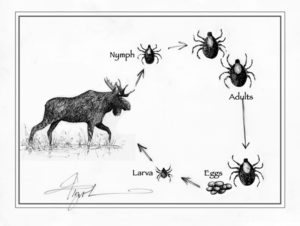By Rachel Sargent Mirus
Legend says a stake through the heart will kill a vampire. But it’s a bit more complicated if you’re plagued – as moose can be – by tens of thousands of tiny blood-suckers. In the case of moose, the vampires are winter ticks (Dermacentor albipictus), and finding a way to stake them has been tricky. However, recent research has found a potential, microscopic, vampire hunter.

Winter ticks are a one-host parasite, meaning all three active stages — larvae, nymphs, and adults — feed on a single host animal. This species prefers to feast on ungulates and is often called the “moose tick” because, unlike deer, moose are unable to remove the ticks through grooming, leaving them particularly vulnerable to large tick loads. Average tick counts on a single moose can hover around 47,000, with high counts topping 96,000.
That many ticks can drain the blood of a calf in two to three weeks. From 2017 to 2019, researchers with the Vermont Cooperative Fish & Wildlife Research Unit at the University of Vermont noted a 91% mortality of moose calves in Vermont. And from 2014 through 2016, researchers from the Dept. of Natural Resources and the Environment at the University of New Hampshire saw 70% mortality in northern New Hampshire and western Maine due to winter ticks.
Such alarming mortality rates have raised concern among wildlife management officials about the health of the New England moose population. Due to the ticks’ life history, however, finding a management strategy for winter ticks has been challenging.
Winter tick larvae quest – or seek hosts – from late summer through fall. After attaching to a host, the ticks feed, molt, and mate on the same animal through the winter. When adult female ticks are maximally engorged – generally between March and May – they drop to the ground. Over the course of summer and early fall, the females lay eggs and die, then the larvae emerge and hang out at soil level and again begin questing.
Because of their one-host nature and the timing of their life cycle, the winter tick population depends on plentiful hosts and a window of time in the fall to find one. Limited hosts, cold fall temperatures, and early snows will inhibit ticks – but these are all conditions that are impractical to manage in favor of moose.
Enter Cheryl Sullivan, an entomologist with the Entomology Research Laboratory at UVM. She is spearheading a project investigating entomopathogenic fungi as potential allies against the winter tick. These fungi consume arthropods like insects, spiders — and, yes, ticks.
Entomopathogenic fungi are found naturally in soils worldwide and infect hosts through aerial spores. When a spore lands on a tick, it germinates, puncturing the tick’s outer shell, then spreads its hyphae – the threads that comprise the fungi’s mycelium network – through the tick’s body. Like something out of a horror movie, the growing fungus tears apart its host’s internal organs and produces toxins, eventually killing the host. Fruiting bodies sprout from the host, releasing more spores.
Sullivan and the team at UVM tested fungal strains of Metarhizium anisopliae and M. brunneum against winter ticks. Some strains are already available commercially to control insects and mites in residential settings, and some were isolated from forest soils in northern Vermont. While commercial strains were most effective, Sullivan found that in laboratory experiments a local strain killed 89% of tick larvae within three weeks.
The UVM researchers are specifically interested in exposing ticks to fungal spores at the larval stage, before they’ve found a host. This is the phase when the winter tick is most vulnerable: the larvae are living in the fungi’s natural home (soil and leaf litter), and both need similarly damp conditions to thrive.
Deliberately exposing ticks to specific fungal pathogens in their environment is a more sustainable alternative to chemical pesticides, although it’s not without challenges. As Sullivan explains, “Entomopathogenic fungi require specific environmental conditions, including temperature and humidity, ample spore contact with a host, and applications timed appropriately to a susceptible life stage for their use to be effective.” Spreading fungal spores everywhere moose live is impractical, so moose conservationists would need to target places Sullivan describes as “localized areas of optimal habitat where moose are known to congregate and be prone to winter tick recruitment.”
While researchers are still evaluating the practicality of using entomopathogenic fungi to attack winter ticks, it is nice to know that when moose are faced with swarms of miniature vampires, they might be helped in the battle by microscopic vampire hunters.
Rachel Sargent Mirus lives in Duxbury, Vermont. Illustration by Adelaide Murphy Tyrol. The Outside Story is assigned and edited by Northern Woodlands magazine and sponsored by the Wellborn Ecology Fund of the New Hampshire Charitable Foundation: nhcf.org.




